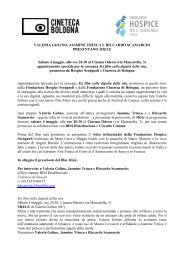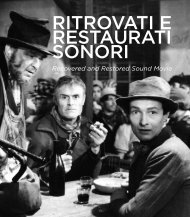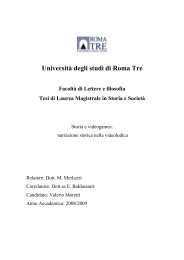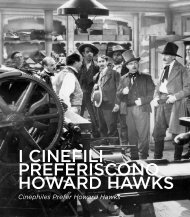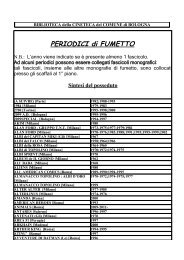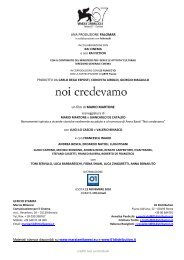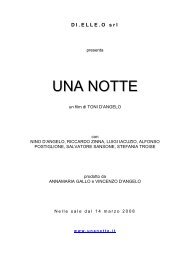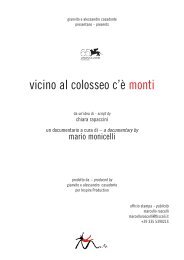You also want an ePaper? Increase the reach of your titles
YUMPU automatically turns print PDFs into web optimized ePapers that Google loves.
lack villain. As one of the protagonists,<br />
it is appropriate that he is depicted as a<br />
<strong>di</strong>rty, frizzy-haired, creepy, rascally Jew,<br />
i.e. as a controversial foil exactly like the<br />
press, taking their cue from Hitler’s blackballing,<br />
liked to present the Israelites.<br />
Semmy Friedmann greatly exaggerates<br />
the character’s Jewishness, unnecessarily<br />
overdramatizing Bendel as a stereotype.<br />
In my opinion, his portrayal is one of the<br />
film’s weaknesses”.<br />
NIEUWE GRONDEN<br />
Paesi Bassi, 1933 Regia: Joris Ivens<br />
█.T..int.:.New Earth..Scen.:.Joris.Ivens..F.:.Joris.<br />
Ivens,.John.Fernhout,.Piet.Huisken,.Helen.van.<br />
Dongen,. Eli. Lotar.. Mo.:. Joris. Ivens,. Helen. van.<br />
Dongen.. Mu.:. Hanns. Eisler.. Int.:. Joris. Ivens.<br />
(narratore).. Prod.:. Capi-Holland.. Pri.. pro.:. 14.<br />
<strong>di</strong>cembre. 1933. █. 35mm.. D.:. 31’.. Bn.. Versione.<br />
olandese.con.sottotitoli.inglesi./.Dutch.version.<br />
with.English.subtitles. █.Da:.EYE.–.Film.Institute.<br />
Netherlands.per.concessione.<strong>di</strong>.Capi.Film.<br />
Il documentario <strong>di</strong> Joris Ivens Zuiderzee<br />
(1930) raccontava una storia quasi troppo<br />
bella per essere vera: un gigantesco progetto,<br />
partito all’inizio degli anni Venti e<br />
completato <strong>di</strong>eci anni dopo, che impiegò<br />
<strong>di</strong>ecimila uomini per compiere una bonifica<br />
che permise <strong>di</strong> strappare al mare terre<br />
coltivabili, nuova fonte <strong>di</strong> ricchezza per un<br />
mondo in preda agli spasmi della Depressione,<br />
dono all’umanità sofferente giunto<br />
con splen<strong>di</strong>do tempismo.<br />
Ciò che accadde in seguito è descritto nella<br />
seconda parte del film <strong>di</strong> Ivens, Nieuwe<br />
gronden. Per mantenere alto il prezzo del<br />
grano, i raccolti delle nuove terre non vengono<br />
venduti. Scorrono titoli <strong>di</strong> giornali:<br />
crollo del mercato del grano. Si lasciano<br />
marcire milioni <strong>di</strong> tonnellate <strong>di</strong> grano.<br />
C’è troppo grano e non abbastanza lavoro.<br />
Il punto <strong>di</strong> vista si allarga al mondo intero,<br />
con le marce contro la fame a Londra e la<br />
fluttuazione dei prezzi del grano. Lo sguardo<br />
concreto, biologico – e, aggiungiamo,<br />
magico – del regista nel mostrare i processi<br />
naturali si estende ai misteri dell’economia<br />
mon<strong>di</strong>ale: la tragica e insensata<br />
oscenità della realtà <strong>di</strong> classe e la scandalosa<br />
incommensurabilità dei ricchi del<br />
mondo e del sistema capitalista. La censura<br />
francese definì il film con una preci-<br />
Nieuwe gronden<br />
sione persino eccessiva: “trop de réalité”.<br />
Insieme al successivo The Spanish Earth<br />
(Terra <strong>di</strong> Spagna), Nieuwe gronden è il miglior<br />
film girato da Joris Ivens negli anni<br />
Trenta. Come il film spagnolo, è un’elegia<br />
del lavoro e un capolavoro <strong>di</strong> drammaturgia<br />
creativa: le riprese furono realizzate da tre<br />
squadre, con una cinepresa per la terraferma,<br />
una per il mare e una terza che si identificava<br />
con gli uomini e le loro macchine.<br />
Ampliando la propria gamma creativa, il<br />
grande regista e <strong>di</strong>rettore della fotografia<br />
aggiunse al proprio vocabolario l’arte del<br />
collage: cinegiornali e filmati d’archivio –<br />
testimonianze sempre più frequenti della<br />
realtà umana – si trasformano in un epocale<br />
montaggio <strong>di</strong> idee. Nieuwe gronden<br />
è al contempo un tesoro <strong>di</strong> verità sociali<br />
e umane, un attento stu<strong>di</strong>o sulla relatività<br />
della verità e un capolavoro <strong>di</strong> ironia drammatica.<br />
Joris Ivens’ documentary Zuiderzee<br />
(1930) told a story almost too good to<br />
believe: a massive project, begun in the<br />
early 1920s and completed ten years later,<br />
had 10,000 men finishing a drainage<br />
project to reclaim fertile land from the sea<br />
for agricultural use – new wealth for the<br />
world in the throes of the Depression, a<br />
harvest with all-time beautiful timing for<br />
suffering mankind.<br />
What happened next led to a renewed<br />
version of Ivens’ film, Nieuwe gronden.<br />
Wheat, instead of being harvested, is<br />
withheld from the market to keep the<br />
price high. Headlines: Grain Market collapses.<br />
Millions of tons of hidden grain lie<br />
rotting.<br />
There is too much grain and not enough<br />
work. The point of view rises to global<br />
scale: marches against hunger in London,<br />
the fluctuation in wheat prices. The<br />
<strong>di</strong>rector’s material, biological – and let’s<br />
add, magical – touch in showing nature’s<br />
processes continue into the mystery of<br />
world economics: the tragic and senseless<br />
obscenity of class realities and the outrageous<br />
incommensurability between the<br />
riches of the world and the capitalist system.<br />
The French censors defined it almost<br />
too accurately: “trop de réalité”.<br />
Along with the forthcoming The Spanish<br />
Earth, Nieuwe gronden is the greatest<br />
Joris Ivens film of the 1930s. Like the<br />
Spanish film, it’s an elegy for human work<br />
and a masterpiece of creative dramaturgy,<br />
procee<strong>di</strong>ng with one camera for the earth,<br />
a second for the sea and a third identifying<br />
with humans and the machines.<br />
Enriching his creative scale, the celebrated<br />
cinematographer and <strong>di</strong>rector added<br />
the art of collage to his vocabulary: newsreels<br />
and archival footage – ever growing<br />
pieces of human testimony – grow into a<br />
landmark montage of ideas. Nieuwe gronden<br />
is a treasure of human and social<br />
truths lying hidden and locked away and,<br />
inseparably, a close study of the relativity<br />
of truth – a masterpiece of dramatic irony.<br />
49



